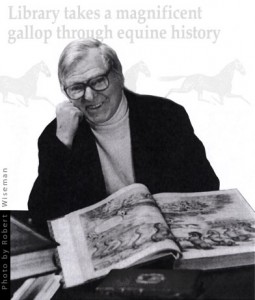Library takes a magnificent gallop through equine history
Just a dozen books, purchased more than 40 years ago, have given rise to what may be the world’s most extensive privately held collection about horses.
Within his Wellesley, Mass., home, John Seaverns – self described “omnivorous collector” – has amassed more than 7,500 non-fiction equestrian books as well as hundreds of pieces of ephemera, including catalogs, annuals, show programs and other materials relating to horses.

John Seaverns with the Duke of Newcastle’s A General System of Horsemanship (1784). Photo by Robert Weisman
“There should be a record of every thing, and I’ve tried to provide that record of the horse,” Seaverns said. His hand-written notebooks provide complete inventory of the collection, which he assembled by visiting book shops, flea markets, book and paper shows and by corresponding with book dealers in this country and abroad.
Seaverns became interested in horses as a teenager, when he helped friends with stablework in Wellesley in exchange for the opportunity to ride. “I was hooked on horses from then on,” he said. Although Seaverns rode intermittently after that, it wasn’t until later that he purchased his first horse. “I started fox hunting when I was 50,” said Seaverns who is past president of the Tanheath Hunt Club of Norfolk and has been president of the Horse and Buggy Club of Holliston for more than twenty years. At age 80, he still owns a horse and rides regularly.
Seaverns’ fondness for all things equestrian permeates his home. Sporting paintings, prints, and photographs – including several of Seaverns astride with the Tanheath Hunt – decorate the walls. An assortment of hunt whips, crops and fly whisks are displayed by the front door, and shiny harness brasses hang from the dark woodwork. A set of English painted lead figures – mounted riders in “pink” coats following a pack of hounds in pursuit of a fox – are among the collectibles atop the bookcases.
Most prominent of all, however, are the books themselves. From floor to ceiling, three rooms are lined with shelves, each filled to capacity with books on all subjects relating to horses. (There’s also a sizable collection of books about dogs.) The comprehensive collection ranges from modern manuals of horsemanship, to early texts on horse health, to century-old, leather-bound breed registries.
The collection is especially strong in racing, hunting, riding, breed histories and equestrian art. Among the rare and important volumes are Federico Grisone’s Gli Ordeni Di Cavalcare et Modi Di Conoscere (1571), an edition of the first printed book on the art of horsemanship; the lavishly engraved Duke of Newcastle’s A General System of Horsemanship (1784); and R.S. Surtees’ The Horseman’s manual (1831), one of Seaverns’ most recent acquisitions.
With a strong conviction that the collection’s future home should be with a New England institution, Seaverns has decided to bequeath it to Tufts School of Veterinary Medicine, where the books and other materials will become a special part of the permanent collection of the school’s Webster Library. In addition, Seaverns has designated in his will that Tufts also receive his house, which will be sold to provide the necessary funding to install, catalog, and support the collection at Tufts. “At Tufts, the collection will remain a resource to the people of New England,” he said.
As a horseman, Seaverns became familiar with the veterinary school soon after it opened in 1979. “Over the years, I’d attended a number of events at Tufts, including the opening of the large animal hospital,” he said. Last spring, Seaverns approached Dr Franklin M. Loew, veterinary school dean, with a proposal regarding a bequest of his equestrian library.
Last fall, Loew visited Seaverns at his home and received a personal tour of the collection. “John Seaverns’ books represent a precious national resource, and I am delighted that his generosity will permit Tufts to share them with scholars and horse people,” Loew said. It’s a truly remarkable and unique collection that reflects the man who assembled it.”
This Article first published in Veterinary World, Tufts University School of Veterinary Medicine, Spring 1995 by Cristin Merck.
Selected texts from the Seaverns collection have been made available online at the Internet Archive.org
